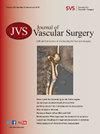预测颈动脉体瘤切除术并发症的术前放射学特征
IF 3.9
2区 医学
Q1 PERIPHERAL VASCULAR DISEASE
引用次数: 0
摘要
背景:颈动脉体肿瘤(CBT)是一种罕见肿瘤,给外科手术带来了巨大挑战。本研究旨在评估一家三级医疗中心接受CBT切除术的患者术前放射学特征对术后并发症的预测作用:方法:对 2003 年至 2023 年期间接受 CBT 切除术的 106 例患者进行回顾性分析。收集了患者的人口统计学特征、肿瘤特征和手术细节。主要结果是估计失血量(EBL)>250 毫升和颅神经(CN)损伤。采用逻辑回归模型确定重要的术前放射学预测因素,包括Shamblin分级、北京协和医院(PUMCH)分级、肿瘤到颅底的距离(DTBOS)和肿瘤体积:结果:共纳入 106 名患者。Shamblin和PUMCH分级越高,EBL和CN损伤越严重。具体来说,仅凭香卜林分级就能预测 EBL >250 mL,其 McFadden R2 值为 0.14,加上 DTBOS 和肿瘤体积后,该值略微下降至 0.13。对于 CN 损伤,单独使用 Shamblin 分级的 R2 值为 0.16,加入 DTBOS 后,R2 值显著提高到 0.27,加入肿瘤体积后,R2 值进一步提高到 0.29。单用 PUMCH 分级预测 EBL >250 mL 的 R2 值为 0.08,在加入 DTBOS 和肿瘤体积后没有明显变化。对于 CN 损伤,单独使用 PUMCH 分级的 R2 值为 0.14,加入 DTBOS 后 R2 值提高到 0.21,加入肿瘤体积后 R2 值提高到 0.22。此外,DTBOS 下降 1 厘米会显著增加需要输血的几率(OR = 2.26,95% CI:1.28-4.01,p=0.0051)和 CN 损伤的风险(OR = 3.65,95% CI:1.98-6.73,p 结论:本研究发现了新的术前放射学预测指标,这些指标提高了标准分类系统的预测准确性,为术前规划提供了宝贵的见解。虽然 Shamblin 和 PUMCH 分类本身是很有用的工具,但我们的研究结果表明,结合其他放射学特征(如 DTBOS 和肿瘤体积)可大大提高其预测效用。我们鼓励外科医生将多种术前放射学变量与传统分类系统结合起来,以更好地评估术后并发症的风险。为了验证这些发现并完善预测模型,有必要对更大规模的多机构队列进行进一步研究。本文章由计算机程序翻译,如有差异,请以英文原文为准。
Preoperative radiological features in predicting complications of carotid body tumor resection
Objective
Carotid body tumors (CBTs) are rare neoplasms that pose significant surgical challenges. This study aims to evaluate the predictive utility of preoperative radiological characteristics on postoperative complications in patients undergoing CBT resection at a tertiary care center.
Methods
A retrospective analysis was conducted on 106 patients who underwent CBT resection between 2003 and 2023. Patient demographics, tumor characteristics, and operative details were collected. The primary outcomes were an estimated blood loss (EBL) >250 mL and cranial nerve (CN) injury. Logistic regression models were used to identify significant preoperative radiological predictors, including Shamblin grade, Peking Union Medical College Hospital (PUMCH) grade, tumor distance to the base of the skull (DTBOS), and tumor volume.
Results
One hundred six patients were included. Higher Shamblin and PUMCH grades were significantly associated with increased EBL and CN injury. Specifically, the Shamblin grade alone predicted an EBL >250 mL with a McFadden R2 value of 0.14, which slightly decreased to 0.13 when DTBOS and tumor volume were added. For CN injury, the Shamblin grade alone had an R2 of 0.16, which significantly improved to 0.27 with the addition of DTBOS and further to 0.29 with tumor volume. The PUMCH grade alone predicted an EBL >250 mL with an R2 value of 0.08, which did not significantly change with the addition of DTBOS and tumor volume. For CN injury, the PUMCH grade alone had an R2 of 0.14, improving to 0.21 with DTBOS and to 0.22 with tumor volume. Furthermore, a 1-cm decrease in DTBOS significantly increased the odds of requiring a blood transfusion (odds ratio, 2.26; 95% confidence interval, 1.28-4.01; P = .0051) and the risk of CN injury (odds ratio, 3.65; 95% confidence interval, 1.98-6.73; P < .0001).
Conclusions
This study identified novel preoperative radiological predictors that enhance the predictive accuracy of standard classification systems, offering valuable insights for preoperative planning. Although the Shamblin and PUMCH classifications are useful tools on their own, our findings demonstrate that incorporating additional radiological features, such as DTBOS and tumor volume, can substantially increase their predictive utility. Surgeons are encouraged to incorporate multiple preoperative radiological variables alongside traditional classification systems to better assess the risk of postoperative complications. Further research with larger, multi-institutional cohorts are necessary to validate these findings and refine predictive models.
求助全文
通过发布文献求助,成功后即可免费获取论文全文。
去求助
来源期刊
CiteScore
7.70
自引率
18.60%
发文量
1469
审稿时长
54 days
期刊介绍:
Journal of Vascular Surgery ® aims to be the premier international journal of medical, endovascular and surgical care of vascular diseases. It is dedicated to the science and art of vascular surgery and aims to improve the management of patients with vascular diseases by publishing relevant papers that report important medical advances, test new hypotheses, and address current controversies. To acheive this goal, the Journal will publish original clinical and laboratory studies, and reports and papers that comment on the social, economic, ethical, legal, and political factors, which relate to these aims. As the official publication of The Society for Vascular Surgery, the Journal will publish, after peer review, selected papers presented at the annual meeting of this organization and affiliated vascular societies, as well as original articles from members and non-members.

 求助内容:
求助内容: 应助结果提醒方式:
应助结果提醒方式:


